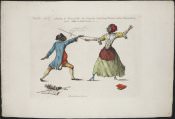The D------ of [...]-- playing at foils with her favorite lap dog Mungo after expending near £10000 to make him a----------*
The D------ of [...]-- playing at foils with her favorite lap dog Mungo after expending near £10000 to make him a----------*
May 1, 1773 (published)
William Austin (printmaker)
1721-1820
Etching, hand-colored, on laid paper
27.3 x 37.6 cm
This satirical print—one in a series of twelve published under the heading Nature Display’d both Serious and Comic—shows Catherine Douglas, Duchess of Queensberry (1701–1777), fencing with her servant, protégé, and reputed lover Julius Soubise (ca. 1754–1798). Soubise was born enslaved on the Caribbean island of St. Kitts. In 1764, he was brought to England aboard a royal naval vessel (his name appears in the ship’s register as Othello) and given to the sixty-three year old Duchess as a gift by the captain. The Duchess, who was a famous beauty and eccentric, doted on her new charge. Under her patronage, Soubise was trained in riding and fencing, and he became famous, in the words of one contemporary, as “one of the most conspicuous fops of the town.”
Echoing Darly’s A Mungo Macaroni, Austin refers to Soubise as “Mungo”—a name commonly given to black servants in eighteenth-century London. This link is reinforced by the words Soubise speaks—“Mungo here, Mungo dere, Mungo every where; Above and below”—which quote the lines of the irreverent West Indian servant (also named Mungo) in Isaac Bickerstaff ’s popular comic opera, The Padlock (1768). Like the relationship between Mungo and his master in The Padlock, the relationship depicted here between Soubise and his mistress is one in which the purportedly natural order of things has been turned on its head, as the besotted Duchess is made the dupe of her servant. In 1777, Soubise was dismissed after being accused of raping the Duchess’s maidservant. He moved to India, where he opened a riding school.
Lewis Walpole Library, Yale University, 773.05.01.09+


![M. Darly (publisher), *My Lord—or the Chapeau Maccaroni*. Lewis Walpole Library, Yale University, 773.03.00.01 [Unknown artist], The Chapeau Macaroni](https://interactive.britishart.yale.edu/sites/default/files/styles/ycba_thumbnail/public/FoE_Darly_The%20Chapeau%20Macaroni.jpg?itok=xQVGlC2a)